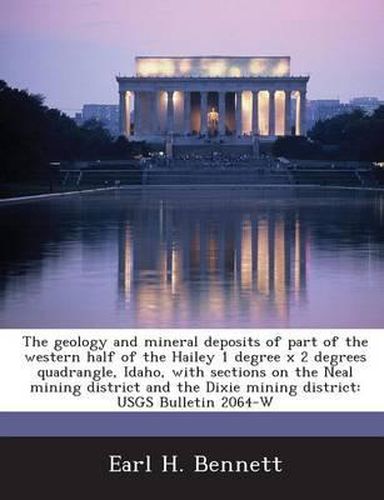Readings Newsletter
Become a Readings Member to make your shopping experience even easier.
Sign in or sign up for free!
You’re not far away from qualifying for FREE standard shipping within Australia
You’ve qualified for FREE standard shipping within Australia
The cart is loading…






Rocks in the western half of the Hailey 1 2 ? quadrangle of south-central Idaho include various units of the Atlanta lobe of the Idaho batholith (biotite granodiorite to two-mica granite) of Cretaceous age and plutons and dikes of Tertiary (Eocene to Miocene) age that intrude the batholith. Eocene plutonic rocks consist of a bimodal suite of anorogenic granite and tonalite-granodiorite and hypabyssal rhyolite and rhyodacite dikes. Rocks of the Eocene Challis Volcanics are scarce in the map area but are widespread to the east. Rhyolite ash flows of the Miocene Idavada Volcanics and basalt of the Snake River Plain crop out in the southern part of the area. Lacustrine rocks of probable Eocene to Holocene age are present in the vicinity of Anderson Ranch Reservoir. Quaternary basalts and gravels are widespread on the South Fork of the Boise River, and alluvial deposits are common along active drainages. Metasedimentary rocks of unknown age crop out on House Mountain, Chimney Peak, and on the ridges east of Anderson Ranch Reservoir. Older structures in the Idaho batholith include a major fault beneath House Mountain that may be a decollement for one of the large thrust sheets in eastern Idaho or part of an extensional core complex. The southern part of the Atlanta lobe of the Idaho batholith is cut by northeast-striking faults (parallel with the Trans-Challis fault system) that are related to Eocene extension and by northwest-oriented faults that formed during basin and range extension in the Miocene. The basin and range faults have prominent scarps typical of basin and range topography. The combination of northeast and northwest faults has broken the batholith into a series of rhomboid blocks. Some of these northeast and northwest faults are older structures that were reactivated in the Eocene or Miocene, as indicated by Ar 40 /Ar 39 dates on mineralized rock contained in some of the structures. The Idaho batholith and associated rocks in the map area host several hundred mines and prospects in 18 mining districts. The deposits range in age from Cretaceous to Eocene, and many were developed for precious metals. Most of the deposits are in quartz veins in shear zones in granitic rocks of the batholith. Several districts were actively being explored for low-grade, bulk-minable, precious-metal deposits in the late 1980s and early 1990s.
$9.00 standard shipping within Australia
FREE standard shipping within Australia for orders over $100.00
Express & International shipping calculated at checkout
Rocks in the western half of the Hailey 1 2 ? quadrangle of south-central Idaho include various units of the Atlanta lobe of the Idaho batholith (biotite granodiorite to two-mica granite) of Cretaceous age and plutons and dikes of Tertiary (Eocene to Miocene) age that intrude the batholith. Eocene plutonic rocks consist of a bimodal suite of anorogenic granite and tonalite-granodiorite and hypabyssal rhyolite and rhyodacite dikes. Rocks of the Eocene Challis Volcanics are scarce in the map area but are widespread to the east. Rhyolite ash flows of the Miocene Idavada Volcanics and basalt of the Snake River Plain crop out in the southern part of the area. Lacustrine rocks of probable Eocene to Holocene age are present in the vicinity of Anderson Ranch Reservoir. Quaternary basalts and gravels are widespread on the South Fork of the Boise River, and alluvial deposits are common along active drainages. Metasedimentary rocks of unknown age crop out on House Mountain, Chimney Peak, and on the ridges east of Anderson Ranch Reservoir. Older structures in the Idaho batholith include a major fault beneath House Mountain that may be a decollement for one of the large thrust sheets in eastern Idaho or part of an extensional core complex. The southern part of the Atlanta lobe of the Idaho batholith is cut by northeast-striking faults (parallel with the Trans-Challis fault system) that are related to Eocene extension and by northwest-oriented faults that formed during basin and range extension in the Miocene. The basin and range faults have prominent scarps typical of basin and range topography. The combination of northeast and northwest faults has broken the batholith into a series of rhomboid blocks. Some of these northeast and northwest faults are older structures that were reactivated in the Eocene or Miocene, as indicated by Ar 40 /Ar 39 dates on mineralized rock contained in some of the structures. The Idaho batholith and associated rocks in the map area host several hundred mines and prospects in 18 mining districts. The deposits range in age from Cretaceous to Eocene, and many were developed for precious metals. Most of the deposits are in quartz veins in shear zones in granitic rocks of the batholith. Several districts were actively being explored for low-grade, bulk-minable, precious-metal deposits in the late 1980s and early 1990s.